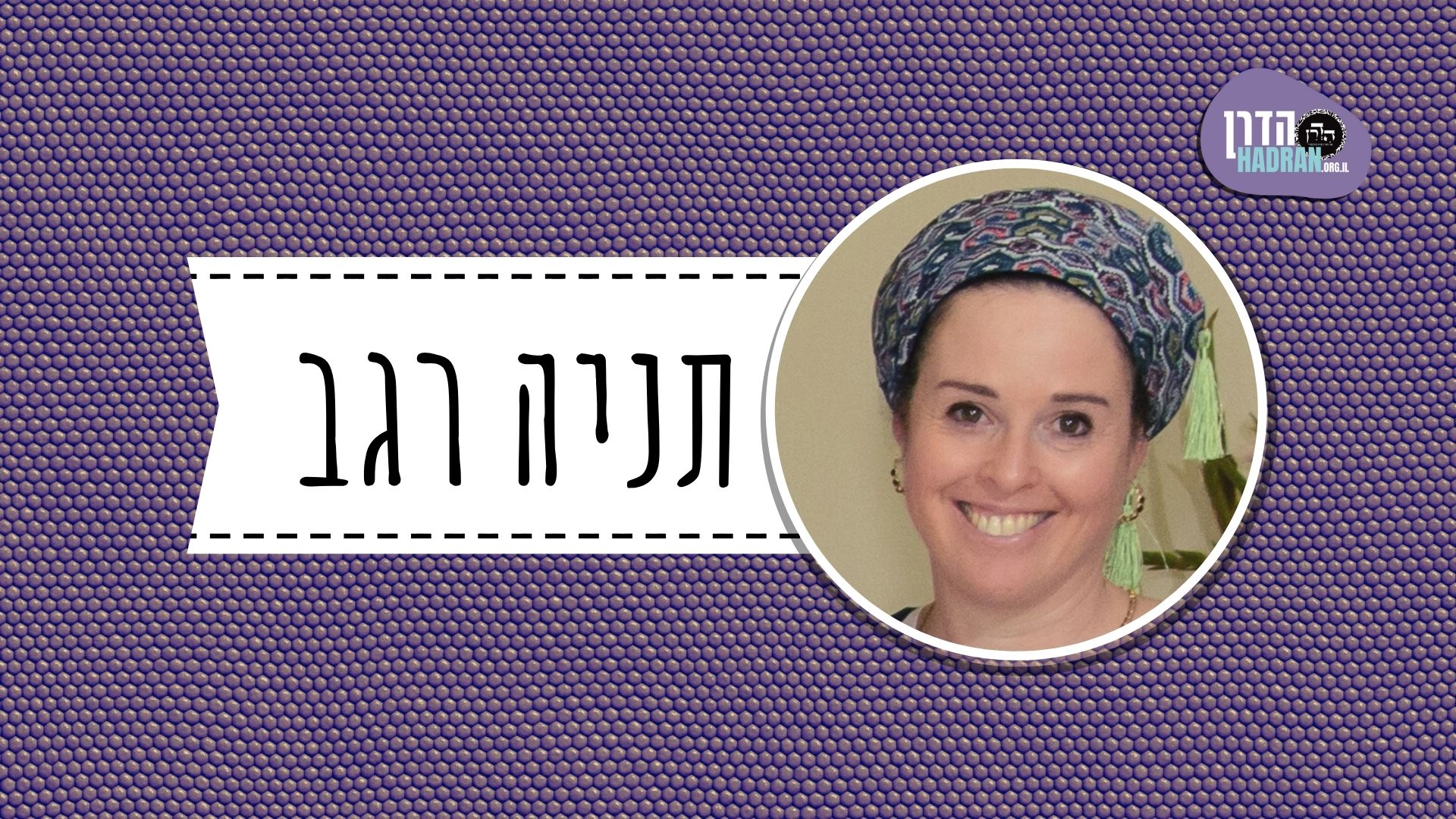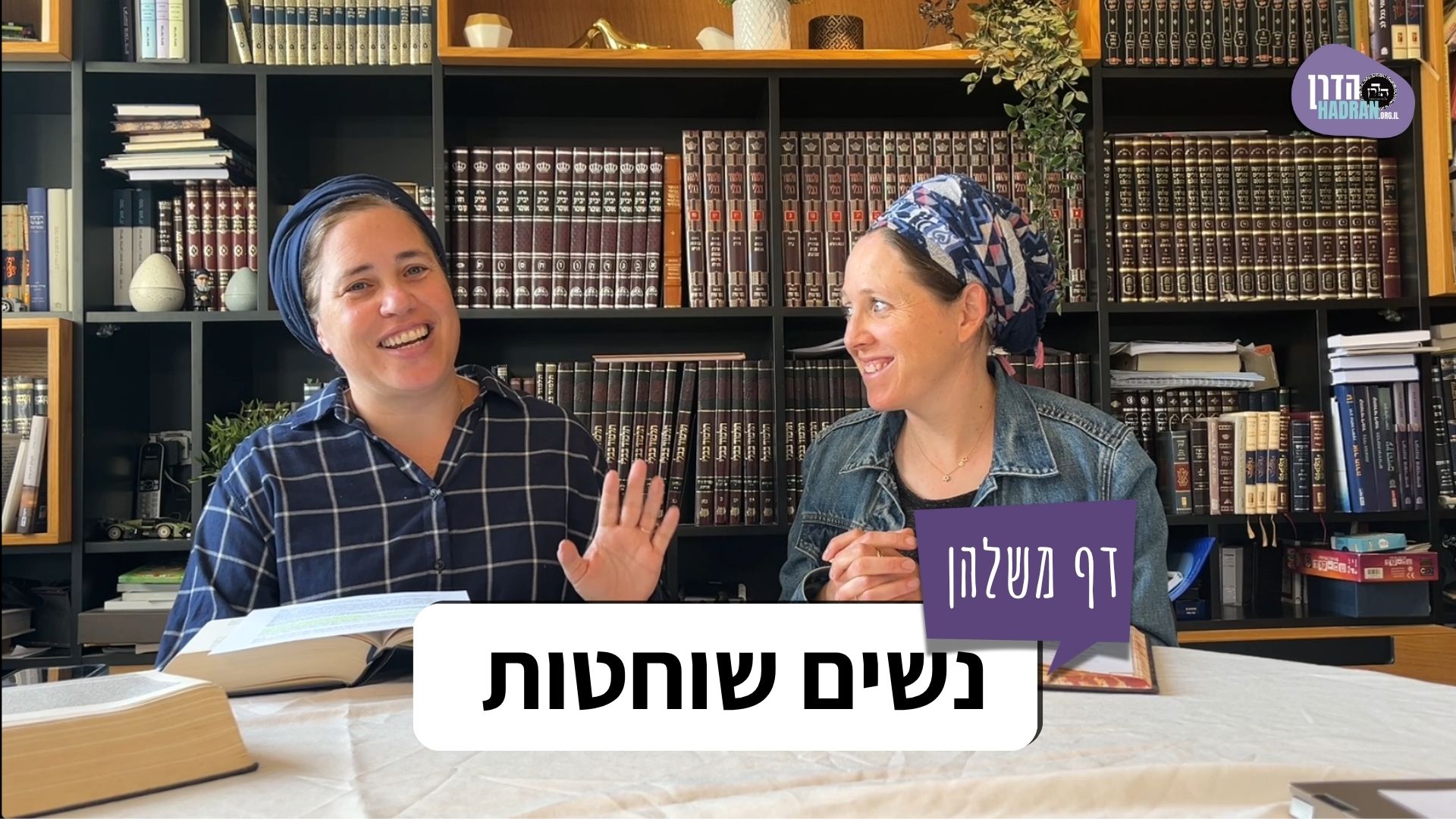מסכת זבחים
מסכת זבחים מוקדש ע”י אסתר קרמר לע”נ אביה מני גרוס.
רוצה להקדיש שיעור?

תקציר
כיצד רבי יהודה מתמודד עם הקשיים שהעלה רב שיזבי? בתחילה מראה הגמרא שהוא דורש את ההלכות שרב שיזבי דרש מהמילה טריפה (שגם הפסוקים על נבלת עוף וגם על חֵלֶב בהמה חלים רק על עופות ובהמות כשרות) בדרך שונה. לאחר מכן מובאות שלוש הצעות כיצד להסביר את משמעות המילה "טרֵפה” בפסוק העוסק בחֵלֶב. שתי ההצעות הראשונות נדחות.
כיצד רבי מאיר מסביר את שלושת הפסוקים על נבילה וטריפה – שניים העוסקים בטומאת עוף מת ואחד העוסק בחֵלֶב?
נאמרת ברייתא שממנה נדרשים חלק מן ההלכות שהוזכרו קודם מתוך הפסוקים, והיא מלמדת שדין החֵלֶב חל רק על בהמות כשרות ולא על חיות.
רבי יוחנן ורבי אלעזר חלוקים האם רבי מאיר סובר שמליקה מוציאה עוף מטומאת נבֵלה גם בעופות בעלי מום או אף בעופות שאינם קרבים על המזבח. מכאן מגיע רבי ירמיה לשאול האם אותו דין יהיה נכון גם אם במקום עריפת עגל בטקס עגלה ערופה היו שוברים את גבו של עז.
כלים
מסכת זבחים
מסכת זבחים מוקדש ע”י אסתר קרמר לע”נ אביה מני גרוס.
כלים
העמקה
רוצה להבין מה באמת קורה מתחת לפני השטח של הסוגיה?
שיעורים, פודקאסטים והרחבות של מיטב המורות שלנו יפתחו לך עוד זוויות וכיווני חשיבה.
חדשה בלימוד הגמרא?
זה הדף הראשון שלך? איזו התרגשות עצומה! יש לנו בדיוק את התכנים והכלים שיעזרו לך לעשות את הצעדים הראשונים ללמידה בקצב וברמה שלך, כך תוכלי להרגיש בנוח גם בתוך הסוגיות המורכבות ומאתגרות.
פסיפס הלומדות שלנו
גלי את קהילת הלומדות שלנו, מגוון נשים, רקעים וסיפורים. כולן חלק מתנועה ומסע מרגש ועוצמתי.
זבחים ע
הַאי נָמֵי תִּיפּוֹק לִי מִ״וְּחֵלֶב נְבֵלָה״ –
The Gemara challenges: According to this logic, one can also derive the halakha that the forbidden fat of the carcass of a non-kosher animal is impure from the verse: “And the fat of a carcass, and the fat of a tereifa, may be used for any other service” (Leviticus 7:24), which teaches that such forbidden fat is ritually pure.
מִי שֶׁאִיסּוּרוֹ מִשּׁוּם בַּל תֹּאכַל חֵלֶב נְבֵלָה; יָצָאתָה זוֹ שֶׁאֵין אִיסּוּרָהּ מִשּׁוּם בַּל תֹּאכַל [חֵלֶב נְבֵלָה], אֶלָּא מִשּׁוּם טָמֵא!
The continuation of the verse: “But you shall in no way eat of it,” indicates that the verse renders pure only fat that is forbidden specifically due to the prohibition: You shall not eat the forbidden fat of a carcass, i.e., the forbidden fat of kosher animals. This serves to exclude this forbidden fat of a non-kosher animal, which is not forbidden due to the prohibition: You shall not eat the forbidden fat of a carcass, but rather due to the prohibition against eating a non-kosher animal. Since the verse that states that fats are ritually pure is referring only to kosher animals, the forbidden fat of a carcass of a non-kosher animal must be impure. Rav Sheizevi’s derivation of this halakha from the word tereifa is therefore superfluous.
אֶלָּא הַאי טְרֵיפָה מִיבְּעֵי לְאֵיתוֹיֵי חַיָּה – סָלְקָא דַּעְתָּךְ אָמֵינָא: מִי שֶׁחֶלְבָּהּ אָסוּר וּבְשָׂרָהּ מוּתָּר, יָצָאת זוֹ שֶׁחֶלְבָּהּ וּבְשָׂרָהּ מוּתָּר; קָא מַשְׁמַע לַן.
Rather, this word “tereifa” is necessary to include the forbidden fat of a carcass of a kosher undomesticated animal, to teach that it is ritually pure; as it might enter your mind to say that only the forbidden fat of carcasses of those animals whose fat is forbidden and whose meat is permitted if slaughtered, i.e., kosher domesticated animals, is ritually pure, and this serves to exclude this forbidden fat of carcasses of those animals whose fat and meat are both permitted if slaughtered, i.e., kosher undomesticated animals, whose fat is impure. To counter this possibility, the word “tereifa” teaches us that the fat of a carcass of any animal that can become a tereifa is ritually pure, including the fat of kosher undomesticated animals.
אֲמַר לֵיהּ: מַאי שְׁנָא טְמֵאָה – דְּאֵין חֶלְבָּהּ חָלוּק מִבְּשָׂרָהּ; חַיָּה נָמֵי – אֵין חֶלְבָּהּ חָלוּק מִבְּשָׂרָהּ! וְעוֹד, הָכְתִיב: ״וְאָכֹל לֹא תֹאכְלוּהוּ״!
He said to him: If it is derived from the verse that the forbidden fat of a carcass of a kosher undomesticated animal is pure, what is different about a non-kosher animal that would cause its forbidden fat to be impure? If the difference is that its fat is not distinct from its meat, as both are forbidden for consumption, the fat of a kosher undomesticated animal is also not distinct from its meat, as both are permitted. And furthermore, isn’t it written later in the verse: “But you shall in no way eat of it” (Leviticus 7:24)? This phrase is interpreted (70b) as excluding the fat of undomesticated animals, teaching that it is impure.
אֶלָּא אָמַר אַבָּיֵי: טְרֵיפָה לְגוּפֵיהּ אִיצְטְרִיךְ; שֶׁלֹּא תֹּאמַר: הוֹאִיל וּטְמֵאָה אֲסוּרָה מֵחַיִּים, וּטְרֵיפָה אֲסוּרָה מֵחַיִּים – מָה טְמֵאָה חֶלְבָּהּ טָמֵא, אַף טְרֵיפָה חֶלְבָּהּ טָמֵא.
Rather, Abaye said: The word “tereifa” in this verse was necessary for its own sake, to teach that the forbidden fat of a carcass of a tereifa of a kosher domesticated animal is pure. The inclusion of the word teaches that you should not say that since a non-kosher animal is forbidden while still alive, and a tereifa is forbidden while still alive, therefore just as the forbidden fat of a non-kosher animal is impure, so too the forbidden fat of a tereifa is impure. The word “tereifa” therefore teaches that it is pure.
אִי הָכִי, הַאי נָמֵי מִיבְּעֵי; שֶׁלֹּא תֹּאמַר: הוֹאִיל וְעוֹף טָמֵא אָסוּר בַּאֲכִילָה, וּטְרֵיפָה אֲסוּרָה בַּאֲכִילָה – מָה עוֹף טָמֵא אֵינוֹ מְטַמֵּא, אַף טְרֵיפָה אֵינָהּ מְטַמְּאָה!
The Gemara asks: But if so, i.e., if one could have learned the halakha of the forbidden fat of a tereifa from the halakha of the forbidden fat of a non-kosher animal, then this word “tereifa” in the verse concerning the impurity of a kosher bird carcass (Leviticus 17:15) is also necessary for its own sake, to teach that the carcass of a kosher bird that is a tereifa is impure. It is necessary for this to be written with regard to the carcass of a kosher bird so that you should not say as follows: Since a non-kosher bird is forbidden for consumption, and a tereifa is forbidden for consumption, therefore just as a non-kosher bird does not impart impurity, so too a tereifa does not impart impurity. According to Rabbi Yehuda, the word is necessary to include the slaughtered kosher bird that is a tereifa, not a carcass.
וְעוֹד, מִי אִיכָּא לְמֵילַף טְרֵפָה מִטְּמֵאָה?! טְמֵאָה לֹא הָיְתָה לָהּ שְׁעַת הַכּוֹשֶׁר, טְרֵיפָה הָיְתָה לָהּ שְׁעַת הַכּוֹשֶׁר! וְכִי תֵּימָא: טְרֵיפָה מִבֶּטֶן מַאי אִיכָּא לְמֵימַר? בְּמִינַהּ מִיהָא אִיכָּא!
And furthermore, is it possible to derive the halakha concerning a tereifa from that concerning a non-kosher animal, as suggested? The two cases are incomparable, as a non-kosher animal never had a kosher period before being forbidden, whereas a tereifa had a kosher period before becoming a tereifa. And if you would say: What can be said with regard to an animal that is a tereifa from the womb, which never had a kosher period? In any event, there are kosher animals among its species, i.e., the tereifa is a member of a kosher species, which cannot be said of a non-kosher animal.
אֶלָּא אָמַר רָבָא, הַתּוֹרָה אָמְרָה: יָבֹא אִיסּוּר נְבֵילָה וְיָחוּל עַל אִיסּוּר חֵלֶב, יָבֹא אִיסּוּר טְרֵיפָה וְיָחוּל עַל אִיסּוּר חֵלֶב.
Rather, Rava said: The word tereifa in the verse concerning forbidden fat (Leviticus 7:24) teaches a different halakha. By stating: “But you shall in no way eat of it,” referring to the forbidden fat of a carcass, the Torah states: Let the prohibition of eating a carcass come and take effect where the prohibition of eating forbidden fat already exists. One who eats the forbidden fat of a carcass is liable both for eating forbidden fat and for eating from a carcass. Likewise, the word “tereifa” in the verse teaches: Let the prohibition of eating a tereifa come and take effect where the prohibition of eating forbidden fat already exists, so that one who eats the forbidden fat of a tereifa is liable for transgressing two prohibitions.
וּצְרִיכִי; דְּאִי אַשְׁמְעִינַן נְבֵילָה – מִשּׁוּם דִּמְטַמְּיָא, אֲבָל טְרֵיפָה אֵימָא לָא; וְאִי אַשְׁמְעִינַן טְרֵיפָה – מִשּׁוּם דְּאִיסּוּרָהּ מֵחַיִּים, אֲבָל נְבֵילָה אֵימָא לָא; צְרִיכָא.
And both the word “carcass” and the word “tereifa” are necessary, even though they teach similar halakhot. As, had the verse taught us about additional liability only with regard to the forbidden fat of a carcass, one might have thought that it applies to only a carcass, as it imparts ritual impurity, but with regard to a tereifa, which does not, one might say that the additional liability does not apply. And had the verse taught us this halakha only with regard to a tereifa, one might have thought that it applies only to a tereifa, as its prohibition takes effect while it is still alive, but with regard to a carcass, which becomes forbidden only when it dies, one might say that it does not apply. Both words are therefore necessary.
וְרַבִּי מֵאִיר, הַאי ״טְרֵפָה״ מַאי עָבֵיד לֵיהּ? מִיבְּעֵי לֵיהּ לְמַעוֹטֵי שְׁחִיטָה שֶׁהִיא לִפְנִים.
§ The Gemara has established that according to Rabbi Yehuda, the word “tereifa” in the verse concerning the impurity of a kosher bird carcass (Leviticus 17:15) teaches that a slaughtered bird that is a tereifa imparts ritual impurity. The Gemara asks: And what does Rabbi Meir, who holds that a slaughtered bird that is a tereifa does not impart ritual impurity, do with this word “tereifa”? The Gemara answers: It is necessary to exclude the slaughter of non-sacred birds that occurs inside the Temple courtyard, teaching that it does not cause them to impart ritual impurity as would a carcass, even though they are forbidden for consumption.
וְרַבִּי יְהוּדָה – ״טְרֵפָה״ אַחֲרִינָא כְּתִיב.
And how does Rabbi Yehuda derive this halakha? The Gemara answers: Another instance of the word tereifa is written concerning the ritual impurity of birds: “A carcass, or a tereifa, he shall not eat to become impure with it” (Leviticus 22:8). Rabbi Yehuda derives the halakha from this verse.
וְרַבִּי מֵאִיר – חַד לְמַעוֹטֵי שְׁחִיטָה שֶׁהִיא לִפְנִים, וְחַד לְמַעוֹטֵי עוֹף טָמֵא.
And how does Rabbi Meir interpret the appearance of the word tereifa in both verses? The Gemara answers: One is necessary to exclude the slaughter that occurs inside the Temple courtyard as mentioned above, and one is necessary to exclude a non-kosher bird, to teach that the carcass of a non-kosher bird does not impart ritual impurity.
וְרַבִּי יְהוּדָה – מִ״נְּבֵלָה״ נָפְקָא לֵיהּ.
And how does Rabbi Yehuda derive that the carcass of a non-kosher bird does not impart ritual impurity? The Gemara answers: He derives it from the word “carcass” in the verse: “A carcass, or a tereifa, he shall not eat to become impure with it” (Leviticus 22:8), which indicates that only carcasses of birds that are forbidden for consumption due to their status as a carcass are impure. Non-kosher birds are forbidden due to their non-kosher status, not due to their status as a carcass.
וְרַבִּי מֵאִיר – הַאי ״נְבֵלָה״ מַאי עָבֵיד לֵהּ? לְשִׁיעוּר אֲכִילָה בִּכְזַיִת.
The Gemara asks: And what does Rabbi Meir do with this word “carcass”? The Gemara answers: Since the verse mentions eating, Rabbi Meir holds that the word “carcass” is written to teach that the minimum measure of consumption of the meat of a bird carcass that renders one impure is an olive-bulk, which is the standard legal measure of consumption for Torah laws in general.
וְתִיפּוֹק לִי מִקְּרָא קַמָּא, מִדְּאַפְּקֵיהּ רַחֲמָנָא בִּלְשׁוֹן אֲכִילָה!
The Gemara challenges: But let him derive this measure from the first verse: “And every soul that eats a carcass…shall be impure” (Leviticus 17:15), from the fact that the Merciful One expresses this halakha using the language of consumption.
חַד לְשִׁיעוּר אֲכִילָה בִּכְזַיִת, וְחַד לְשִׁיעוּר אֲכִילָה בִּכְדֵי אֲכִילַת פְּרָס.
The Gemara responds: Both verses are necessary, one to indicate that the measure of consumption that renders one impure is an olive-bulk, and one to indicate that the maximum measure of time for consumption of the olive-bulk is the time it takes to eat a half-loaf of bread. One who takes longer than this standard measure of time will not contract impurity.
סָלְקָא דַּעְתָּךְ אָמֵינָא: הוֹאִיל וְחִידּוּשׁ הוּא – יוֹתֵר מִכְּדֵי אֲכִילַת פְּרָס נָמֵי לִיטַמֵּא; קָא מַשְׁמַע לַן.
It is necessary for the Torah to indicate this latter halakha as well, as otherwise it might enter your mind to say: Since the impurity of carcasses of birds is a novelty, as one contracts it by eating rather than by touching or carrying, perhaps its halakhot are unusually stringent and even one who eats an olive-bulk in more than the time it takes to eat a half-loaf of bread should also contract impurity. Therefore, the verse teaches us otherwise.
תָּנוּ רַבָּנַן: ״וְחֵלֶב נְבֵלָה וְחֵלֶב טְרֵפָה״ – בְּחֵלֶב בְּהֵמָה טְהוֹרָה הַכָּתוּב מְדַבֵּר.
§ The Gemara cites a baraita concerning the impurity of the forbidden fat of a carcass. The Sages taught: When the verse: “And the fat of a carcass, and the fat of a tereifa, may be used for any other service” (Leviticus 7:24) teaches that such fat is pure, the verse speaks of the forbidden fat of a kosher animal.
אַתָּה אוֹמֵר בְּחֵלֶב בְּהֵמָה טְהוֹרָה הַכָּתוּב מְדַבֵּר; אוֹ אֵינוֹ אֶלָּא בְּחֵלֶב בְּהֵמָה טְמֵאָה?
The baraita challenges: Do you say that the verse speaks of the forbidden fat of a kosher animal, or perhaps does it only speak of the forbidden fat of a non-kosher animal?
אָמַרְתָּ: טִיהֵר מִכְּלַל שְׁחוּטָה, וְטִיהֵר מִכְּלַל חֵלֶב; מָה כְּשֶׁטִּיהֵר מִכְּלַל שְׁחוּטָה – בִּטְהוֹרָה וְלֹא בִּטְמֵאָה, אַף כְּשֶׁטִּיהֵר מִכְּלַל חֵלֶב – בִּטְהוֹרָה וְלֹא בִּטְמֵאָה.
You may say in response: The Torah renders a slaughtered animal pure of the impurity of a carcass due to the fact that it was ritually slaughtered. And likewise the Torah renders the forbidden fat of a carcass pure, due to the fact that it is forbidden fat. Therefore, the two cases are comparable: Just as when the Torah renders a slaughtered animal pure due to the fact that it was slaughtered, it is referring only to a kosher animal and not to a non-kosher animal, which is impure even when ritually slaughtered, so too, when the Torah renders forbidden fat pure due to the fact that it is forbidden fat, it is referring only to a kosher animal and not to a non-kosher animal.
אוֹ כְּלָךְ לְדֶרֶךְ זוֹ: טִיהֵר מִכְּלַל נְבֵילָה, וְטִיהֵר מִכְּלַל חֵלֶב; מָה כְּשֶׁטִּיהֵר מִכְּלַל נְבֵילָה – בִּטְמֵאָה וְלֹא בִּטְהוֹרָה, אַף כְּשֶׁטִּיהֵר מִכְּלַל חֵלֶב – בִּטְמֵאָה וְלֹא בִּטְהוֹרָה!
The baraita challenges: Or perhaps go this way and maintain that since the Torah renders the carcass of a non-kosher animal ritually pure, removing it from the category of a carcass, and likewise the Torah renders the forbidden fat of a carcass pure, due to the fact that it is forbidden fat; therefore, the two cases are comparable: Just as when the Torah renders the carcass of a non-kosher animal pure, removing it from the category of a carcass, it is referring only to a non-kosher animal and not to a kosher animal, the carcass of which imparts impurity, so too, when the Torah renders forbidden fat pure due to the fact that it is forbidden fat, it is referring only to a non-kosher animal and not to a kosher animal.
אָמְרַתְּ:
You may say in response:
כְּשֶׁבָּא בְּדֶרֶךְ זוֹ – הִיא בִּטְהוֹרָה, וּכְשֶׁבָּא בְּדֶרֶךְ זוֹ – הִיא בִּטְמֵאָה; תַּלְמוּד לוֹמַר: ״טְרֵפָה״ – מִי שֶׁיֵּשׁ בְּמִינָהּ טְרֵיפָה.
When one approaches the matter this first way, the halakha that forbidden fat is pure applies specifically to kosher animals, but when one approaches the matter that second way, the halakha applies specifically to non-kosher animals. To decide the matter, the verse states: “The fat of a tereifa may be used for any other service” (Leviticus 7:24), indicating that only the forbidden fat of those animals to whose species the halakha of tereifa applies, i.e., kosher animals, is ritually pure. The status of tereifa is immaterial to a non-kosher animal as its consumption is prohibited in any event.
אוֹצִיא אֶת הַטְּמֵאָה – שֶׁאֵין בְּמִינָהּ טְרֵיפָה, וְלֹא אוֹצִיא אֶת הַחַיָּה שֶׁיֵּשׁ בְּמִינָהּ טְרֵיפָה! תַּלְמוּד לוֹמַר: ״וְאָכֹל לֹא תֹאכְלוּהוּ״ – מִי שֶׁחֶלְבָּהּ אָסוּר וּבְשָׂרָהּ מוּתָּר, יָצָא חַיָּה שֶׁחֶלְבָּהּ וּבְשָׂרָהּ מוּתָּר.
The baraita concludes: One might still assume that I will exclude from this halakha only the forbidden fat of a carcass of a non-kosher animal, as the halakha of tereifa does not apply to its species, but I will not exclude the fat of a carcass of an undomesticated kosher animal, as the halakha of tereifa applies to its species. Therefore, the verse states in conclusion: “But you shall in no way eat of it,” indicating that the reference is only to animals whose fat is forbidden for consumption if slaughtered but whose meat is permitted, i.e., kosher domesticated animals. Excluded are kosher undomesticated animals, whose fat and meat are both permitted for consumption.
אֲמַר לֵיהּ רַב יַעֲקֹב בַּר אַבָּא לְרָבָא: אֶלָּא מֵעַתָּה – נִבְלַת בְּהֵמָה טְהוֹרָה הוּא דִּמְטַמְּאָה, נִבְלַת בְּהֵמָה טְמֵאָה לָא מְטַמְּאָה?! אֲמַר לֵיהּ: כַּמָּה סָבֵי שַׁבֵּישְׁתּוּ בַּהּ! סֵיפָא אֲתָאן לְנִבְלַת עוֹף טָמֵא.
Rav Ya’akov bar Abba said to Rava: If that is so, it appears from the baraita that the carcass of a kosher animal imparts impurity, but the carcass of a non-kosher animal does not impart impurity. Rava said to him: How many elders have you caused to err in the interpretation of this baraita? In the latter clause we come to discuss only the carcass of a non-kosher bird, which does not impart impurity. By contrast, carcasses of non-kosher animals are impure.
אָמַר רַבִּי יוֹחָנָן: לֹא טִיהֵר רַבִּי מֵאִיר אֶלָּא בִּתְמִימִין, אֲבָל בְּבַעֲלֵי מוּמִין לָא. וְרַבִּי אֶלְעָזָר אָמַר: אֲפִילּוּ בְּבַעֲלֵי מוּמִין. אִיתְּמַר נָמֵי, אָמַר רַב בִּיבִי אָמַר רַבִּי אֶלְעָזָר: מְטַהֵר הָיָה רַבִּי מֵאִיר בְּבַעֲלֵי מוּמִין, וַאֲפִילּוּ בַּאֲוָוזִין וְתַרְנְגוֹלִין.
§ In the mishna, Rabbi Meir states that a bird offering whose nape was pinched and was found to be a tereifa does not impart impurity as would a carcass. Rabbi Yoḥanan says: Rabbi Meir deemed pure only unblemished birds whose napes were pinched, as they are fit to be sacrificed, but he did not deem pure blemished birds, which are not fit to be sacrificed. And Rabbi Elazar says: Rabbi Meir deemed even blemished birds pure and did not distinguish between the two. It was also stated that Rav Beivai says that Rabbi Elazar says: Rabbi Meir would deem pure blemished birds, and this was his opinion even concerning geese and chickens, species that may not be brought as offerings and as such are never supposed to be pinched.
בָּעֵי רַבִּי יִרְמְיָה: עָרַף עֵז, מַהוּ?
Rabbi Yirmeya raises a dilemma: According to Rabbi Elazar’s understanding of Rabbi Meir’s opinion, what is the halakha with regard to one who broke the neck of a goat? Does the impurity of animal carcasses apply? The breaking of the neck is considered the proper procedure in certain cases, as the Torah commands that a heifer’s neck be broken if a murdered body is found between two cities and the identity of the murderer is unknown (see Deuteronomy 21:4).
אֲוָוזִין וְתַרְנְגוֹלִין טַעְמָא מַאי – דְּמִינָא דְּעוֹפוֹת נִינְהוּ, אֲבָל עֵז לָאו מִינָא דְּעֶגְלָה נִינְהוּ; אוֹ דִילְמָא מִינָא דִּבְהֵמָה הוּא?
One could claim: What is the reason that geese and chickens are pure if their napes are pinched? It is because they are species of birds and the napes of some birds are pinched; but a goat is not of the same species as a heifer, as goats are considered small livestock whereas cattle are large livestock. Or perhaps one could claim: Since a goat is still a species of domesticated animal, it is similar enough to a heifer that the breaking of its neck prevents it from imparting impurity as a carcass.
יָתֵיב רַב דִּימִי וְקָאָמַר לַהּ לְהָא שְׁמַעְתָּא, אֲמַר לֵיהּ אַבָּיֵי: מִכְּלָל דְּעֶגְלָה עֲרוּפָה טְהוֹרָה הִיא?! אֲמַר לֵיהּ: אִין, אָמְרִי דְּבֵי רַבִּי יַנַּאי: כַּפָּרָה כְּתִיב בָּהּ כְּקָדָשִׁים.
Rav Dimi was sitting and saying this halakha, i.e., this dilemma. Abaye said to him: By inference from this dilemma, it seems that you assume that a heifer whose neck is broken is itself pure and does not impart impurity as would a carcass. Rav Dimi said to him: Indeed, as the Sages of the school of Rabbi Yannai say: Since the language of atonement is written with regard to the heifer whose neck is broken, in the verse: “Forgive, Lord, Your people Israel” (Deuteronomy 21:8), just as atonement is written with regard to sacrificial animals, the breaking of the heifer’s neck is equivalent to the pinching of the nape of a bird offering, and breaking its neck prevents the heifer from imparting ritual impurity.
מֵתִיב רַב נָתָן אֲבוּהּ דְּרַב הוּנָא (בַּר נָתָן): ״וְאָכֹל לֹא תֹאכְלוּהוּ״ – אֵין לִי אֶלָּא חֵלֶב שֶׁאָסוּר בַּאֲכִילָה וּמוּתָּר בַּהֲנָאָה; חֵלֶב שֶׁל שׁוֹר הַנִּסְקָל וְעֶגְלָה עֲרוּפָה – מִנַּיִן?
Rav Natan, father of Rav Huna bar Natan, raises an objection based on a baraita concerning the purity of the forbidden fat of a kosher animal, mentioned in the verse: “And the fat of a carcass, and the fat of a tereifa, may be used for any other service; but you shall in no way eat of it” (Leviticus 7:24). I have derived from the verse only that forbidden fat that is forbidden for consumption but from which deriving benefit is permitted is pure. From where is it derived that this halakha also applies to the forbidden fat of an ox that is stoned by the court or the forbidden fat of a heifer whose neck is broken, from both of which one is prohibited from deriving benefit?
תַּלְמוּד לוֹמַר: ״כׇּל חֵלֶב״.
The verse states: “You shall eat no fat nor blood” (Leviticus 3:17). The generalization “no fat” indicates that the same halakhot apply to the forbidden fats of all domesticated kosher animals, including those from which one is prohibited from deriving benefit.
וְאִי סָלְקָא דַעְתָּךְ עֶגְלָה עֲרוּפָה טְהוֹרָה הִיא – הִיא טְהוֹרָה וְחֶלְבָּהּ טָמֵא?!
Rav Natan concludes his objection: And if it enters your mind that the meat of a heifer whose neck is broken is pure, why must the verse teach that its forbidden fat is pure? Could one entertain the possibility that its meat is pure but its forbidden fat is impure?
הֵיכָא דַּעֲרַף מִיעְרָף – לָא אִיצְטְרִיכָא לֵיהּ; כִּי אִיצְטְרִיכָא, הֵיכָא דְּשַׁחְטַהּ מִישְׁחָט.
The Gemara responds: The derivation in the baraita was not necessary for a case where one broke the neck of the heifer. It was necessary for the verse to teach that the forbidden fat is pure even in a case where one slaughtered a heifer whose neck was designated to be broken.
וְתֵיהָנִי לֵיהּ שְׁחִיטָה לְטַהֲרָהּ מִידֵּי נְבֵלָה! לָא צְרִיכָא, שֶׁמֵּתָה.
The Gemara asks: But the slaughter itself should be effective in purifying the forbidden fat, as slaughter prevents an animal from assuming the impure status of a carcass, and the derivation is still superfluous. The Gemara responds: No, it is necessary to teach that the forbidden fat of a heifer that died before its neck could be broken is pure even though the heifer itself assumes that status of a carcass.
מִכְּלָל דְּמֵחַיִּים אֲסוּרָה? אִין. אָמַר רַבִּי יַנַּאי: גְּבוּל שָׁמַעְתִּי וְשָׁכַחְתִּי, וְנָסְבִין חַבְרַיָּיא לְמֵימַר: יְרִידָתָהּ לְנַחַל אֵיתָן הִיא אוֹסַרְתָּהּ.
The Gemara asks: If the baraita is referring only to a heifer that died before its neck could be broken, and it describes benefitting from it as being prohibited, by inference, is it prohibited to derive benefit from the heifer while it is still alive? The Gemara responds: Indeed, as Rabbi Yannai says: I heard the boundary, i.e., stage, beyond which it is forbidden, but I have forgotten what it is, and yet the members of the group of scholars were inclined to say that its descent to a hard valley (see Deuteronomy 21:4), where its neck was broken, is the action that renders it forbidden.
הֲדַרַן עֲלָךְ חַטַּאת הָעוֹף
מַתְנִי׳ כׇּל הַזְּבָחִים שֶׁנִּתְעָרְבוּ בְּחַטָּאוֹת הַמֵּתוֹת אוֹ בְּשׁוֹר הַנִּסְקָל, אֲפִילּוּ אַחַת בְּרִיבּוֹא – יָמוּתוּ כּוּלָּן. נִתְעָרְבוּ בְּשׁוֹר שֶׁנֶּעֶבְדָה בּוֹ עֲבֵירָה, אוֹ
MISHNA: All the offerings that were intermingled with animals from which deriving benefit is forbidden, e.g., sin offerings left to die, or with an ox that was sentenced to be stoned, even if the ratio is one in ten thousand, deriving benefit from them all is prohibited and they all must die. If the offerings were intermingled with animals whose sacrifice is forbidden but deriving benefit from them is not, the halakha is different. Examples of this are an ox with which a transgression was performed, which disqualifies it from being sacrificed as an offering, or




















